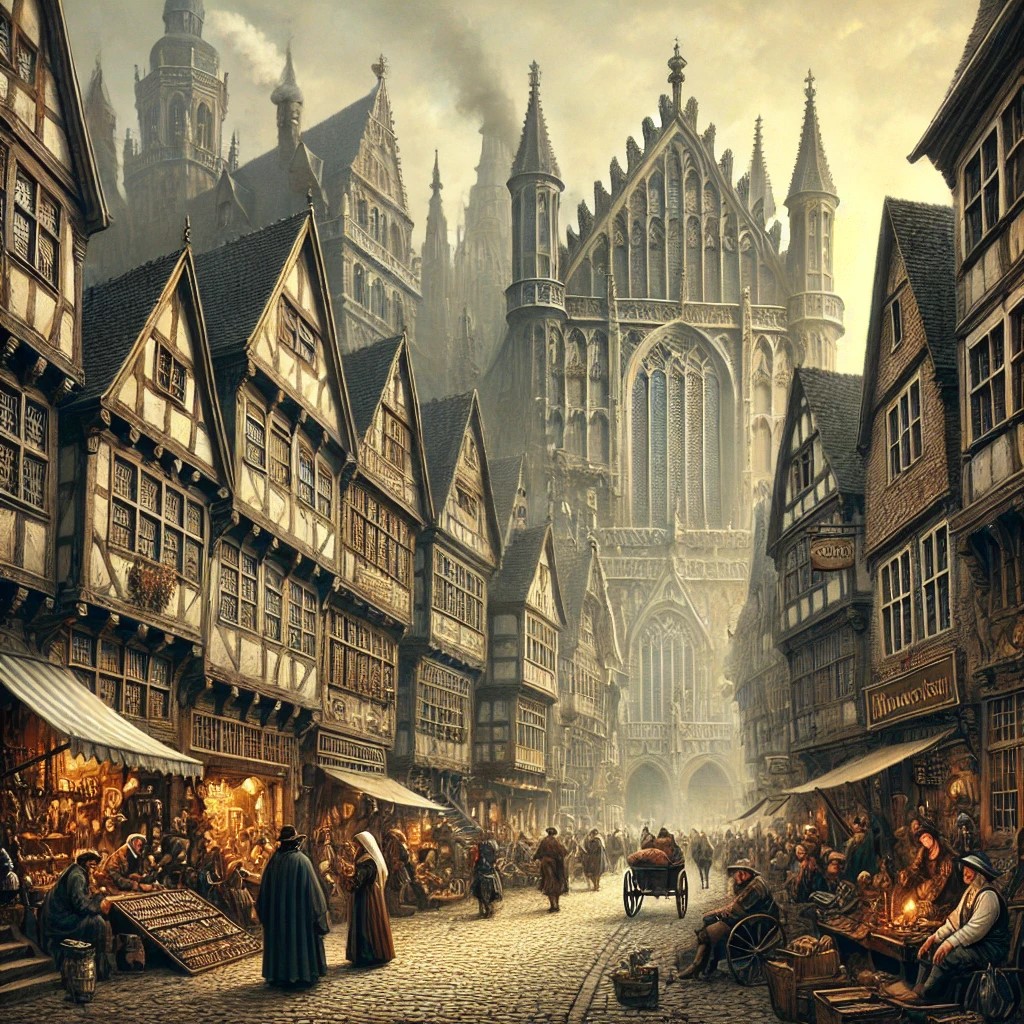Difference between revisions of "Aachen"
Tao alexis (talk | contribs) |
Tao alexis (talk | contribs) |
||
| (10 intermediate revisions by the same user not shown) | |||
| Line 1: | Line 1: | ||
| − | '''Aachen''' is a [[Free City | + | [[File:Aachen.jpg|right|525px|thumb]] |
| + | '''Aachen''' is a '''[[Free City]]''' within the '''[[Holy Roman Empire]]''', known for its sulphur springs, long-standing trade connections and its historical significance as a site of imperial coronations. It lies about 45 miles west of [[Cologne]] on the northern edge of the Ardennes Mountains, in a region of rolling hills and dense forests. The city sits in a warm, moist climate that feeds its mineral-rich waters, drawing visitors seeking their healing properties. The springs remain a source of wealth, as nobles, clergy and merchants continue to visit Aachen's baths and spas, maintaining its reputation as a city of comfort and respite. | ||
| + | __TOC__ | ||
| + | Once the favoured residence of [[Charlemagne]], Aachen's Minster Cathedral remains its most prominent landmark. The Aix-la-Chapelle Chapel, built as Charlemagne's palace chapel between 796 and 805, serves as the heart of the cathedral, its octagonal design an enduring symbol of the city's imperial past. Though the coronations of emperors moved to [[Frankfurt-am-Main]] in 1531, Aachen still holds religious significance, housing relics and drawing pilgrims to the site of Charlemagne's tomb. | ||
| − | + | The city is enclosed by walls, with fortified gates controlling entry. Within these walls, Aachen's layout consists of narrow, winding streets, lined with timber-framed houses, workshops and market stalls. The Grashaus, once the city's original town hall, stands in the medieval green, a space still used for executions and festivals. The current town hall, built in the 14th century, dominates the city center, where the council oversees trade, law and taxation. | |
| − | + | == Trade == | |
| + | Aachen is a vital '''[[Market|market]]''' hub, trading extensively with [[Gladbach]] and the [[Julich|Duchy of Jülich]]. Its industries include the production of lead, silver, zinc, cloth, glassware, pig iron, needles and tools, sustaining a steady flow of goods between Aachen and the surrounding regions. Caravans from Cologne, the Low Countries and the Rhine Valley bring textiles, metals and exotic wares, ensuring a constant exchange of wealth and resources. Guilds control much of the production, regulating quality and securing their influence within the city's economy. | ||
| − | [[Category: | + | The aftermath of the [[Thirty Years' War]] has left its mark on Aachen, as it has on much of the empire. While spared the worst destruction, the war has disrupted trade and soldiers-turned-bandits still haunt the countryside. Political instability has shifted allegiances and while Aachen maintains its status as a Free City, tensions between Catholic and Protestant factions remain a source of unrest. Despite this, daily life continues — markets are busy, guilds remain strong and pilgrims and merchants alike still arrive at Aachen’s gates. The city's wealth may not match its former glory, but it endures as a place of commerce, faith and healing. |
| + | |||
| + | |||
| + | [[Category: Places in Germany]] | ||
Latest revision as of 01:13, 18 February 2025
Aachen is a Free City within the Holy Roman Empire, known for its sulphur springs, long-standing trade connections and its historical significance as a site of imperial coronations. It lies about 45 miles west of Cologne on the northern edge of the Ardennes Mountains, in a region of rolling hills and dense forests. The city sits in a warm, moist climate that feeds its mineral-rich waters, drawing visitors seeking their healing properties. The springs remain a source of wealth, as nobles, clergy and merchants continue to visit Aachen's baths and spas, maintaining its reputation as a city of comfort and respite.
Contents
Once the favoured residence of Charlemagne, Aachen's Minster Cathedral remains its most prominent landmark. The Aix-la-Chapelle Chapel, built as Charlemagne's palace chapel between 796 and 805, serves as the heart of the cathedral, its octagonal design an enduring symbol of the city's imperial past. Though the coronations of emperors moved to Frankfurt-am-Main in 1531, Aachen still holds religious significance, housing relics and drawing pilgrims to the site of Charlemagne's tomb.
The city is enclosed by walls, with fortified gates controlling entry. Within these walls, Aachen's layout consists of narrow, winding streets, lined with timber-framed houses, workshops and market stalls. The Grashaus, once the city's original town hall, stands in the medieval green, a space still used for executions and festivals. The current town hall, built in the 14th century, dominates the city center, where the council oversees trade, law and taxation.
Trade
Aachen is a vital market hub, trading extensively with Gladbach and the Duchy of Jülich. Its industries include the production of lead, silver, zinc, cloth, glassware, pig iron, needles and tools, sustaining a steady flow of goods between Aachen and the surrounding regions. Caravans from Cologne, the Low Countries and the Rhine Valley bring textiles, metals and exotic wares, ensuring a constant exchange of wealth and resources. Guilds control much of the production, regulating quality and securing their influence within the city's economy.
The aftermath of the Thirty Years' War has left its mark on Aachen, as it has on much of the empire. While spared the worst destruction, the war has disrupted trade and soldiers-turned-bandits still haunt the countryside. Political instability has shifted allegiances and while Aachen maintains its status as a Free City, tensions between Catholic and Protestant factions remain a source of unrest. Despite this, daily life continues — markets are busy, guilds remain strong and pilgrims and merchants alike still arrive at Aachen’s gates. The city's wealth may not match its former glory, but it endures as a place of commerce, faith and healing.
